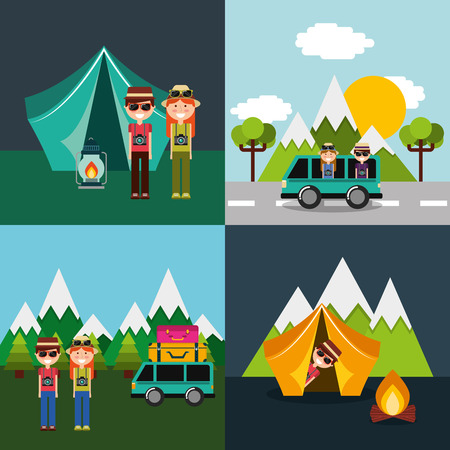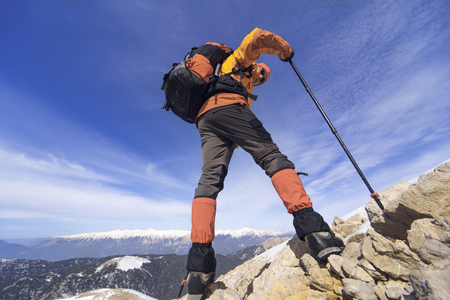Introduction: The Roots of Hiking Clubs in American Outdoor Culture
Step onto a winding forest trail in America and you’re tracing the footsteps of generations who cherished the land long before it became public policy. Hiking clubs have been woven into the fabric of American outdoor life since the late 19th century, born from a restless spirit to explore and protect wild places. Early pioneers, inspired by transcendentalists like John Muir and Henry David Thoreau, gathered in small groups—first for camaraderie, then for a larger cause. These grassroots organizations quickly became more than just social circles; they were a call to action to preserve sprawling landscapes from unchecked development and to cultivate a deeper appreciation for wilderness. As cities expanded and railroads crisscrossed the nation, hiking clubs acted as guardians of natural sanctuaries, fostering an ethos where every hike was both a celebration of nature’s grandeur and a pledge to safeguard it for future generations. This foundational connection between recreation and preservation set the stage for hiking clubs to become influential voices in America’s environmental movement.
2. Grassroots Impact: Building Community for Conservation
Hiking clubs have long served as the beating heart of grassroots conservation efforts in the United States. These organizations go beyond organizing weekend treks; they act as powerful catalysts for community engagement, education, and hands-on stewardship. Through their boots-on-the-ground approach, hiking clubs create a sense of collective responsibility that inspires everyday Americans to take an active role in preserving local trails and wild spaces.
Community Engagement Through Shared Experiences
At the core of every hiking club is a vibrant community built around shared passion for nature. Whether it’s sunrise hikes along the Blue Ridge or trail maintenance in the Cascades, these experiences forge deep connections among members. This camaraderie often translates into lifelong commitments to local trail systems and parklands, transforming casual hikers into vocal advocates for preservation initiatives.
Education as a Foundation for Stewardship
Education is another crucial pillar of hiking club activities. Many clubs offer workshops, guided hikes, and guest speaker events focused on topics like Leave No Trace principles, native plant identification, or the history of protected lands. By fostering environmental literacy, these programs empower members with the knowledge needed to become effective stewards of their own backyard trails.
Grassroots Action: From Trail Days to Policy Advocacy
Grassroots action is where hiking clubs truly shine. Regular “trail days” mobilize volunteers for everything from litter cleanups to invasive species removal and trail repair. These visible acts of stewardship not only keep trails safe and accessible but also demonstrate a living commitment to conservation—often catching the attention of local policymakers.
| Club Activity | Impact on Conservation |
|---|---|
| Trail Maintenance Days | Improves trail safety, prevents erosion, extends trail lifespan |
| Educational Workshops | Raises awareness, builds environmental literacy among members |
| Community Events & Outreach | Engages new advocates, strengthens support for local parks |
| Policy Forums & Town Halls | Gives hikers a voice in local land management decisions |
This grassroots model proves especially effective in rallying public support when issues threaten beloved trails or natural areas. By weaving together community building, education, and direct action, hiking clubs ensure that conservation remains a locally owned—and fiercely defended—priority across America’s diverse landscapes.

3. A Voice in Policy: Advocacy on Regional and National Levels
Hiking clubs have emerged as influential advocates for environmental preservation, shaping policy not just through boots on the trail but by raising their collective voices where it matters most. At the regional level, many clubs participate in public forums and town hall meetings, making sure that the concerns of outdoor enthusiasts are heard during discussions about land use, conservation easements, and park management. Their presence provides a real-time connection between policymakers and the people who know these landscapes intimately—those who walk their ridgelines and rest beneath their pines.
On a broader scale, hiking organizations often partner with environmental coalitions and national nonprofits to amplify their advocacy. By collaborating with groups like the Sierra Club or The Wilderness Society, local hiking clubs can contribute to larger campaigns focused on protecting public lands or influencing legislation such as the Land and Water Conservation Fund. These partnerships enable even small clubs to make an outsized impact, providing grassroots testimony and mobilizing their membership to contact elected officials when key decisions are on the table.
In recent years, digital advocacy has become another tool in the hiker’s kit. Clubs harness social media platforms to rally support for wilderness bills, spread awareness about threatened areas, and coordinate letter-writing drives that reach representatives at both state capitals and Capitol Hill. Whether it’s supporting new trail corridors or defending established ones from development, these efforts demonstrate how hiking clubs have become important stakeholders in shaping America’s environmental future—standing guard over mountains, forests, and open spaces for generations yet to lace up their boots.
4. Case Studies: Success Stories in Preservation
Across the United States, hiking clubs have stepped up as powerful advocates for environmental preservation. Their grassroots efforts and collective voices have left an indelible mark on public policy, from securing protected wilderness areas to ensuring sustainable trail management. Below are some real-life examples showcasing how these passionate communities have shaped the fate of America’s wild places.
Appalachian Trail Conservancy: Safeguarding a National Treasure
The Appalachian Trail Conservancy (ATC), in collaboration with local hiking clubs like the Potomac Appalachian Trail Club, played a pivotal role in preserving the iconic Appalachian Trail corridor. By partnering with federal agencies and mobilizing volunteers, these organizations have not only maintained over 2,000 miles of trails but also influenced legislation such as the National Trails System Act. Their work has protected hundreds of thousands of acres from development and ensured that future generations can experience this legendary path.
Sierra Club: Advocacy Beyond the Trailhead
Founded by John Muir in California, the Sierra Club is one of America’s most influential conservation organizations. Through its network of local hiking chapters, the club has launched campaigns to protect threatened habitats—including ancient forests and fragile alpine meadows—by lobbying for state and federal protections. A notable victory was their instrumental role in establishing Kings Canyon National Park, which preserved vital ecosystems and created lasting outdoor recreation opportunities.
Washington Trails Association: Mobilizing Volunteers for Policy Change
The Washington Trails Association (WTA) demonstrates how boots-on-the-ground stewardship translates into policy wins. WTA’s massive volunteer trail maintenance program has been paired with effective advocacy efforts at the state legislature, resulting in increased funding for public lands and improved regulations around trail access. Their approach empowers everyday hikers to become voices for conservation.
Snapshot: Hiking Club Preservation Successes
| Hiking Club/Organization | Key Achievement | Impact |
|---|---|---|
| Appalachian Trail Conservancy | Secured land protection along the AT corridor | Preserved 250,000+ acres; influenced federal policy |
| Sierra Club | Lobbied for creation of national parks | Helped establish Kings Canyon & other parks; protected habitats |
| Washington Trails Association | Volunteer-powered advocacy for trail funding & access | Improved trail conditions; secured state-level conservation funding |
A Shared Vision for Wild Spaces
These stories illustrate how hiking clubs turn passion into action—transforming scenic walks into enduring legacies for public lands. Whether it’s rallying members to write letters or leading restoration projects on rugged slopes, their local knowledge and collective spirit are driving forces behind some of America’s most celebrated preservation successes.
5. Challenges and Opportunities in Modern Advocacy
As hiking clubs continue to champion the preservation of Americas natural landscapes, they face a new set of challenges that test both their resolve and creativity. One of the most pressing obstacles is funding. Many clubs operate on tight budgets, relying heavily on donations, grants, and volunteer labor. With increased competition for financial support from other environmental organizations, hiking clubs must find innovative ways to sustain their operations and fund their advocacy initiatives.
Another major hurdle lies in representation. Hiking clubs have historically been seen as exclusive or insular groups, which can limit their influence on broader policy discussions. To make a real impact, clubs are working to diversify their membership and leadership, ensuring that voices from all backgrounds and communities are included in conversations about conservation. This shift not only strengthens their advocacy but also fosters a more inclusive outdoor culture.
Perhaps the greatest challenge comes from the accelerating impacts of climate change. Trails once thought permanent are increasingly vulnerable to wildfires, flooding, and erosion. These environmental shifts force hiking clubs to rethink traditional stewardship approaches. Rather than simply maintaining trails, many organizations are now advocating for comprehensive climate resilience strategies at local and national levels.
In response to these challenges, hiking clubs are adapting by embracing technology and forming strategic partnerships. Digital platforms allow clubs to mobilize supporters quickly, share real-time information about threatened areas, and amplify their message far beyond traditional boundaries. Collaborations with scientists, land managers, and community groups help clubs leverage shared resources and expertise.
The modern landscape of advocacy also presents opportunities. By engaging in policy-making processes—such as public comment periods or lobbying efforts—clubs can directly influence decisions that shape public lands. Educational campaigns raise awareness among hikers about responsible recreation and the importance of civic engagement. Through these evolving strategies, hiking clubs remain vital advocates for the wild places Americans love.
6. Cultivating Future Trailblazers
Hiking clubs across the United States are planting the seeds for tomorrow’s environmental stewards by nurturing new generations of hikers and advocates. Through dynamic initiatives that blend education, inclusive outreach, and hands-on engagement, these organizations are ensuring that love for America’s wild places continues to grow.
Mentorship Programs and Youth Education
Many hiking clubs have launched mentorship programs designed to connect experienced trail veterans with young enthusiasts. By guiding first-time hikers through the basics of outdoor ethics, Leave No Trace principles, and local conservation efforts, mentors foster not just skill but a deep respect for the land. Clubs often partner with schools, scout groups, and youth centers, integrating environmental education into after-school activities and summer camps.
Expanding Access and Building Community
Recognizing the importance of inclusivity, hiking clubs are reaching out to communities historically underrepresented in outdoor recreation. Initiatives like bilingual guided hikes, adaptive programs for those with disabilities, and scholarships for gear make trails accessible to all. These efforts encourage a diverse new generation to experience America’s landscapes firsthand, breaking down barriers one step at a time.
Hands-On Stewardship in Action
Education goes beyond lectures—clubs regularly organize trail maintenance days, habitat restoration projects, and citizen science outings where participants get their hands dirty. By involving newcomers directly in conservation work, hiking clubs instill a sense of ownership and responsibility for public lands. This boots-on-the-ground approach ensures that advocacy is not just theoretical but rooted in real-world action.
Through these multifaceted initiatives, hiking clubs are cultivating future trailblazers—equipping them with the knowledge, passion, and practical skills necessary to champion preservation and influence environmental policy for years to come.


